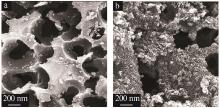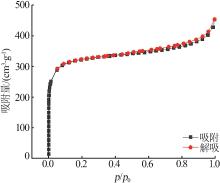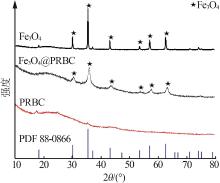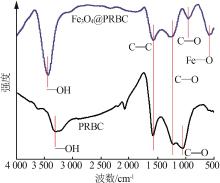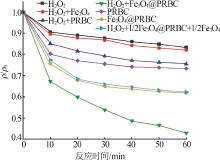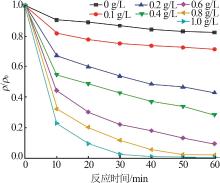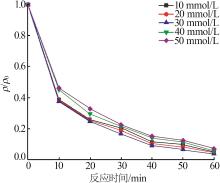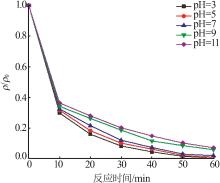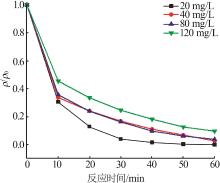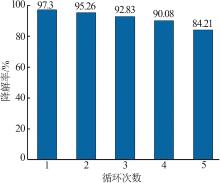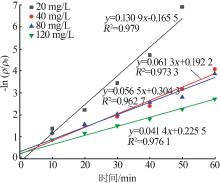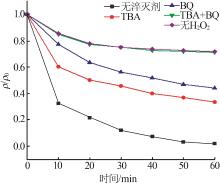Inorganic Chemicals Industry ›› 2023, Vol. 55 ›› Issue (4): 111-119.doi: 10.19964/j.issn.1006-4990.2022-0370
• Catalytic Materials • Previous Articles Next Articles
Catalytic degradation of Rhodamine B by ferroferric oxide-loaded bacterial residue biochar
LIU Rui1( ), GAO Wei1, ZHANG Wenjing2,3, AN Hongxue2,3, LI Zaixing2,3(
), GAO Wei1, ZHANG Wenjing2,3, AN Hongxue2,3, LI Zaixing2,3( )
)
- 1. School of Civil Engineering,Hebei University of Science and Technology,Shijiazhuang 050018,China
2. School of Environmental Science and Engineering,Hebei University of Science and Technology,Shijiazhuang 050018,China
3. State Key Laboratory Breeding Base-Hebei Province Key Laboratory of Molecular Chemistry for Drug,Shijiazhuang 050018,China
-
Received:2022-06-17Online:2023-04-10Published:2023-04-13
CLC Number:
Cite this article
LIU Rui, GAO Wei, ZHANG Wenjing, AN Hongxue, LI Zaixing. Catalytic degradation of Rhodamine B by ferroferric oxide-loaded bacterial residue biochar[J]. Inorganic Chemicals Industry, 2023, 55(4): 111-119.
share this article
Table 2
Performance of different catalysts for catalytic degradation of RhB"
| 样品 | 制备方法 | 反应条件 | 降解率/% | 循环性能 |
|---|---|---|---|---|
| Fe3O4@PRBC | 青霉素菌渣热解制备生物炭、共沉淀法负载Fe3O4 | pH=3、催化剂用量为0.8 g/L、H2O2用量 为30 mmol/L | 97.30 | 循环4次,降解率仍大于90% |
| 磁性Fe3O4纳米微球[ | 乙二醇溶剂热法制备Fe3O4微球 | pH=3、催化剂用量为1.2 g/L、H2O2用量 为140 mmol/L | 接近完全去除 | 未研究 |
| Fe3O4@NiSiO3纳米颗粒[ | 采用Ni刻蚀Fe3O4@SiO2外壳制备 Fe3O4@NiSiO3纳米颗粒 | pH=5.5、催化剂用量为1.0 g/L、H2O2用量 为2.50% | 大于95 | 循环5次,未有明显下降 |
| BC-FeOOH[ | 水热法制备BC-FeOOH | 催化剂用量为0.6 g/L、H2O2用量为10 mmol/L | 达到90 | 循环3次,降解率在 80%左右 |
| Fe0-MF-RGO[ | 磁性还原氧化石墨烯负载零价纳米铁 | pH=7、催化剂用量为1.0 g/L、H2O2用量 为0.8 mmol/L | 98.17 | 循环5次,降解率为 72.97% |
| Fe/SBA-15[ | 以介孔二氧化硅SBA-15为载体,采用等体积浸渍法制备Fe/SBA-15 | pH=5.4、催化剂用量为0.15 g/L、n(H2O2)/ n(Fe3+)=2 000 | 约93 | 循环6次,降解率维持在80% |
| 1 | RIBEIRO A R, NUNES O C, PEREIRA M F R,et al.An overview on the advanced oxidation processes applied for the treatment of water pollutants defined in the recently launched Directive 2013/39/EU[J].Environment International,2015,75:33-51. |
| 2 | JIANG Yu, RAN Jiabing, MAO Kang,et al.Recent progress in Fenton/Fenton-like reactions for the removal of antibiotics in aqueous environments[J].Ecotoxicology and Environmental Safety,2022,236.Doi:10.1016/j.ecoenv.2022.113464 . |
| 3 | GUO Li, ZHANG Kailai, HAN Xuanxuan,et al.Highly efficient visible-light-driven photo-Fenton catalytic performance over FeOOH/Bi2WO6 composite for organic pollutant degradation[J].Journal of Alloys and Compounds,2020,816.Doi:10.1016/j.jallcom.2019.152560 . |
| 4 | JIAO Yue, WAN Caichao, BAO Wenhui,et al.Facile hydrothermal synthesis of Fe3O4@cellulose aerogel nanocomposite and its application in Fenton-like degradation of Rhodamine B[J].Carbohydrate Polymers,2018,189:371-378. |
| 5 | ORTIZ-ZARCO E, SOLIS-CASADOS D, ESCOBAR-ALARCÓN L,et al.Visible light-driven photocatalyst:An iron(Ⅲ) coordination compound in Rhodamine B degradation[J].Journal of Photochemistry and Photobiology A:Chemistry,2022,424.Doi:10.1016/j.jphotochem.2021.113629. |
| 6 | NGUYEN L T T, VO D V N, NGUYEN L T H,et al.Synthesis,characterization,and application of ZnFe2O4@ZnO nanoparticles for photocatalytic degradation of Rhodamine B under visible-light illumination[J].Environmental Technology & Innovation,2022,25.Doi:10.1016/j.eti.2021.102130 . |
| 7 | VAN VIET P, VAN CHUYEN D, HIEN N Q,et al.Visible-light-induced photo-Fenton degradation of Rhodamine B over Fe2O3-diatomite materials[J].Journal of Science:Advanced Materials and Devices,2020,5(3):308-315. |
| 8 | IQBAL A, CEVIK E, ALAGHA O,et al.Highly robust multilayer nanosheets with ultra-efficient batch adsorption and gravity-driven filtration capability for dye removal[J].Journal of Industrial and Engineering Chemistry,2022,109:287-295. |
| 9 | LIU Meng, YIN Wei, ZHAO Tianlei,et al.High-efficient removal of organic dyes from model wastewater using Mg(OH)2-MnO2 nanocomposite:Synergistic effects of adsorption,precipitation,and photodegradation[J].Separation and Purification Technology,2021,272.Doi:10.1016/j.seppur.2021.118901 . |
| 10 | RINGWAL S, BARTWAL A S, SATI S C.Photo-catalytic degradation of different toxic dyes using silver nanoparticles as photo-catalyst,mediated via Citrus aurantium peels extract[J].Journal of the Indian Chemical Society,2021,98(12).Doi:10.1016/j.jics.2021.100221 . |
| 11 | YU Chunxiu, XIONG Zhaokun, ZHOU Hongyu,et al.Marriage of membrane filtration and sulfate radical-advanced oxidation processes(SR-AOPs) for water purification:Current developments,challenges and prospects[J].Chemical Engineering Journal,2022,433.Doi:10.1016/j.cej.2021.133802 . |
| 12 | LIN Ruoyun, LI Yang, YONG Tianzhi,et al.Synergistic effects of oxidation,coagulation and adsorption in the integrated Fenton-based process for wastewater treatment:A review[J].Journal of Environmental Management,2022,306.Doi:10.1016/j.jenvman. 2022.114460 . |
| 13 | LU Sen, LIU Libing, DEMISSIE H,et al.Design and application of metal-organic frameworks and derivatives as heterogeneous Fenton-like catalysts for organic wastewater treatment:A revi-ew[J].Environment International,2021,146.Doi:10.1016/j.envint.2020.106273 . |
| 14 | REKHATE C V, SRIVASTAVA J K.Recent advances in ozone-based advanced oxidation processes for treatment of wastewater-A review[J].Chemical Engineering Journal Advances,2020,3.Doi:10.1016/j.ceja.2020.100031 . |
| 15 | 侯琳萌,清华,吉庆华.类芬顿反应的催化剂、原理与机制研究进展[J].环境化学,2022,41(6):1843-1855. |
| HOU Linmeng, QING Hua, JI Qinghua.Research progress on catalysts,principles and mechanisms of Fenton-like reactions[J].Environmental Chemistry,2022,41(6):1843-1855. | |
| 16 | NIDHEESH P V, GOPINATH A, RANJITH N,et al.Potential role of biochar in advanced oxidation processes:A sustainable approach[J].Chemical Engineering Journal,2021,405.Doi:10.1016/j.cej.2020.126582 . |
| 17 | TAN Xiaofei, LIU Yunguo, GU Yanling,et al.Biochar-based nano-composites for the decontamination of wastewater:A review[J].Bioresource Technology,2016,212:318-333. |
| 18 | 王秋菊.抗生素菌渣与污泥热解资源化利用效能与机理研究[D].哈尔滨:哈尔滨工业大学,2021. |
| WANG Qiuju.Research on the efficiencies and mechanisms of antibiotic residues and sludge pyrolysis for resource utilization[D].Harbin:Harbin Institute of Technology,2021. | |
| 19 | WANG Tao, LIU Xiqing, XU Ting,et al.Lignin-controlled photocatalyst of porous BiVO4-C nanocomposite for enhancing photocatalytic activity toward pollutant under visible-light[J].Applied Surface Science,2020,523.Doi:10.1016/j.apsusc.2020.146401 . |
| 20 | 李安玉,李双莉,余碧戈,等.镁浸渍生物炭吸附氨氮和磷:制备优化和吸附机理[J].化工学报,2020,71(4):1683-1695. |
| LI Anyu, LI Shuangli, YU Bige,et al.Adsorption of ammonia nitrogen and phosphorus by magnesium impregnated biochar:Preparation optimization and adsorption mechanism[J].CIESC Journal,2020,71(4):1683-1695. | |
| 21 | CHENG Zhuoying, LI Shaopeng, NGUYEN T T,et al.Biochar loaded on MnFe2O4 as Fenton catalyst for Rhodamine B removal:Characterizations,catalytic performance,process optimization and mechanism[J].Colloids and Surfaces A:Physicochemical and Engineering Aspects,2021,631.Doi:10.1016/j.colsurfa. 2021.127651 . |
| 22 | BAIG M M, ZULFIQAR S, YOUSUF M A,et al.Dy x MnFe2- x O4 nanoparticles decorated over mesoporous silica for environmental remediation applications[J].Journal of Hazardous Materials,2021,402.Doi:10.1016/j.jhazmat.2020.123526 . |
| 23 | ZHANG Yingshuang, JIANG Hongru, WANG Hui,et al.Separation of hazardous polyvinyl chloride from waste plastics by flotation assisted with surface modification of ammonium persulfate:Process and mechanism[J].Journal of Hazardous Materials,2020,389.Doi:10.1016/j.jhazmat.2019.121918 . |
| 24 | MANEERUNG T, LIEW J, DAI Yanjun,et al.Activated carbon derived from carbon residue from biomass gasification and its application for dye adsorption:Kinetics,isotherms and thermodynamic studies[J].Bioresource Technology,2016,200:350-359. |
| 25 | KARKI H P, OJHA D P, JOSHI M K,et al.Effective reduction of p-nitrophenol by silver nanoparticle loaded on magnetic Fe3O4/ATO nano-composite[J].Applied Surface Science,2018,435:599-608. |
| 26 | LI Mengxue, LIU Haibo, CHEN Tianhu,et al.Synthesis of magnetic biochar composites for enhanced uranium(Ⅵ) adsorption[J].Science of the Total Environment,2019,651:1020-1028. |
| 27 | LIU Banghai, GUO Wanqian, WANG Huazhe,et al.B-doped graphitic porous biochar with enhanced surface affinity and electron transfer for efficient peroxydisulfate activation[J].Chemical Engineering Journal,2020,396.Doi:10.1016/j.cej.2020.125119 . |
| 28 | HUANG Ruixiong, FANG Zhanqiang, YAN Xiaomin,et al.Heterogeneous sono-Fenton catalytic degradation of Bisphenol A by Fe3O4 magnetic nanoparticles under neutral condition[J].Chemical Engineering Journal,2012,197:242-249. |
| 29 | YE Guirong, ZHOU Jinghong, HUANG Renting,et al.Magnetic sludge-based biochar derived from Fenton sludge as an efficient heterogeneous Fenton catalyst for degrading Methylene blue[J].Journal of Environmental Chemical Engineering,2022,10(2).Doi:10.1016/j.jece.2022.107242 . |
| 30 | CHEN Meiqing, CHEN Zhihao, WU Pingxiao,et al.Simultaneous oxidation and removal of arsenite by Fe(Ⅲ)/CaO2 Fenton-like technology[J].Water Research,2021,201.Doi:10.1016/j.watres.2021.117312 . |
| 31 | VILARDI G, SEBASTIANI D, MILIZIANO S,et al.Heterogeneous nZVI-induced Fenton oxidation process to enhance biodegradability of excavation by-products[J].Chemical Engineering Journal,2018,335:309-320. |
| 32 | FU Dun, KURNIAWAN T A, LI Heng,et al.Co-oxidative removal of arsenite and tetracycline based on a heterogeneous Fenton-like reaction using iron nanoparticles-impregnated biochar[J].Environmental Pollution,2021,290.Doi:10.1016/j.envpol.2021. 118062 . |
| 33 | GAO Jing, LIU Yutang, XIA Xinnian,et al.Fe1- x Zn x S ternary solid solution as an efficient Fenton-like catalyst for ultrafast degradation of phenol[J].Journal of Hazardous Materials,2018,353:393-400. |
| 34 | 王晓瑾,李育珍,王梅,等.磁性Fe3O4纳米微球与H2O2类芬顿体系催化氧化罗丹明B[J].太原理工大学学报,2019,50(2):167-172. |
| WANG Xiaojin, LI Yuzhen, WANG Mei,et al.Catalytic oxidation of Rhodamine B by magnetic Fe3O4 nanospheres and H2O2 Fenton-like system[J].Journal of Taiyuan University of Technology,2019,50(2):167-172. | |
| 35 | 牛建瑞,贾秀秀,李宗泽,等.Fe3O4@NiSiO3催化剂制备及其催化芬顿氧化降解染料性能[J].科学技术与工程,2018,18(14):298-304. |
| NIU Jianrui, JIA Xiuxiu, LI Zongze,et al.Preparation of Fe3O4@NiSiO3 nanocatalyst and performance of catalytic Fenton oxidation to degrade dye wastewater[J].Science Technology and Engineering,2018,18(14):298-304. | |
| 36 | 张晓,胡春,张丽丽,等.生物质炭强化FeOOH类芬顿催化性能及其机制[J].环境科学学报,2020,40(11):3895-3904. |
| ZHANG Xiao, HU Chun, ZHANG Lili,et al.Enhanced Fenton-like catalytic performance of FeOOH by biochar and its mechanism[J].Acta Scientiae Circumstantiae,2020,40(11):3895-3904. | |
| 37 | 邓翠萍,谢裕畴,汪文思,等.磁性还原氧化石墨烯负载Fe0对罗丹明B的类芬顿降解[J].环境工程学报,2017,11(6):3499-3506. |
| DENG Cuiping, XIE Yuchou, WANG Wensi,et al.Heterogeneous Fenton degradation of Rhodamine-B by Fe0 assembled on magnetic reduced graphene oxide[J].Chinese Journal of Environmental Engineering,2017,11(6):3499-3506. | |
| 38 | 胡龙兴,许丹丹,邹联沛,等.介孔Fe/SBA-15非均相芬顿氧化水中难降解染料罗丹明B[J].物理化学学报,2015,31(4):771-782. |
| HU Longxing, XU Dandan, ZOU Lianpei,et al.Heterogeneous Fenton oxidation of Refractory dye Rhodamine B in aqueous solution with mesoporous Fe/SBA-15[J].Acta Physico-Chimica Sinica,2015,31(4):771-782. |
| [1] | SUN Haijie, CHENG Yuan, TIAN Yuan, LIU Hongyan, CHEN Zhihao. Preparation of BiOI/g-C3N4 catalyst and its photocatalytic degradation performance of Rhodamine B [J]. Inorganic Chemicals Industry, 2023, 55(8): 36-44. |
| [2] | CHEN Zhangxu, ZHU Danchen, FU Minglian. Study on preparation of g-C3N4/TiO2 composites and application for rhodamine B removal [J]. Inorganic Chemicals Industry, 2023, 55(7): 130-136. |
| [3] | FAN Fangfang, TONG Zhongkai, ZUO Weiyuan. Study on adsorption of tetracycline from wastewater by calcium modified peanut shell biochar [J]. Inorganic Chemicals Industry, 2023, 55(6): 109-115. |
| [4] | TIAN Yuling, CHENG Yang, HAN Rong, ZHOU Mei, WANG Chengjie, GE Qiangru. Effect of CaO on heavy metals stability and adsorption properties of sludge-derived biochar [J]. Inorganic Chemicals Industry, 2023, 55(6): 124-129. |
| [5] | GAO Fei, DONG Liangfei, GE Yulong, TANG Yuanyuan, LI Fen. Study on preparation of sludge biochar/attapulgite and its adsorption properties [J]. Inorganic Chemicals Industry, 2023, 55(5): 91-99. |
| [6] | CHEN Xiudong,ZHANG Yihuan,ZHANG Haodong,SHENG Donghe,WU Jiawei,LIU Jinhang,YAN Ping,ZHAN Changchao. Degradation of rhodamine B by β-FeOOH modified montmorillonite compounded with H2O2 [J]. Inorganic Chemicals Industry, 2022, 54(5): 116-120. |
| [7] | LI Yalin,HUANG Yu,Li Dongao,SUI Zhaoyi,HE Haiyang,LIU Haozhao. Preparation of Fe-impregnated biochar from food waste by solvothermal method [J]. Inorganic Chemicals Industry, 2022, 54(11): 96-103. |
| [8] | GUAN Zhiyuan,ZHANG Xiaowei,WANG Mitang,ZHANG Dongliang,ZHU Changle. Effect of rare earth element of Ce and Nd co-doped with zinc oxide on photocatalytic performance of degradation of Rhodamine B [J]. Inorganic Chemicals Industry, 2022, 54(10): 155-162. |
| [9] | Wang Lixia,Ren Dongmei,Wang Qiong,Chang Chun. Stduy on preparation of magnetic metal-organic frame materials and their adsorption properties [J]. Inorganic Chemicals Industry, 2021, 53(9): 46-50. |
| [10] | Liang Ning,Mo Fujin,Zhou Jierong,Wang Junzheng. Study on preparation of sludge biochar and its adsorption performance for phosphorus [J]. Inorganic Chemicals Industry, 2021, 53(6): 174-179. |
| [11] | Huang Xiameng. Preparation of photocatalytic materials of Bi4O7/BiOBr and study on their photocatalytic performance [J]. Inorganic Chemicals Industry, 2021, 53(4): 112-116. |
| [12] | ZHU Danchen,LI Mingjie,CHEN Zhangxu,LIN Qian. Study on hydrothermal synthesis of MnO2 and its decolorization performance on dyes [J]. Inorganic Chemicals Industry, 2021, 53(11): 60-65. |
| [13] | Li Haichao,Ji Qingsong,Zhang Jingjing,Yang Siqiao. Purification of industrial potassium chloride from salt lake by activated pig bone biochar [J]. Inorganic Chemicals Industry, 2020, 52(8): 76-77. |
| [14] | Zhou Jian,Tang Hongbo. Preparation and photocatalytic properties of ZnWO4/Ag3PO4 composite photocatalyst [J]. Inorganic Chemicals Industry, 2020, 52(6): 101-104. |
| [15] | Hu Dongwan,Ma Zhanling,Ma Xiao,Li Jianrong. Preparation of modified Fe3O4-pectin magnetic microspheres and its adsorption property for Pb 2+ [J]. Inorganic Chemicals Industry, 2020, 52(6): 24-29. |
| Viewed | ||||||
|
Full text |
|
|||||
|
Abstract |
|
|||||
|
||
